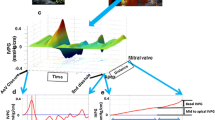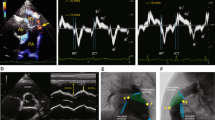Abstract
Aims
To determine whether TAPSE is an accurate marker of right ventricular (RV) systolic function in patients with tetralogy of Fallot (TOF) and patients with small atrial septal defect (ASD). The tricuspid annular plane systolic excursion (TAPSE) values were measured and compared with RV ejection fraction (EF).
Methods and results
A prospective study was conducted in pediatric and adolescent patients with TOF (n = 110), with isolated small secundum ASD (n = 200), and age-matched patients with normally structured heart. The TAPSE values showed a positive correlation with age in both patients with ASD and normal subjects. No significant difference of TAPSE values was seen in control subjects and age-matched ASD patients. The TAPSE was not decreased compared to normal subjects in eight infant TOF patients before corrective surgery. A reduction of TAPSE values with increasing time interval following corrective surgery was seen. After a mean of 7 years TAPSE values become significantly reduced compared to age-matched controls, being below the lower bound of the −2 SD.
Conclusion
In ASD patients the systolic RV function was preserved over the pediatric age group when compared to normal subjects. In contrast, although initially preserved, we found an impaired TAPSE with increasing postoperative period in our TOF patients.




Similar content being viewed by others
Abbreviations
- ASD:
-
Atrial septal defect
- BSA:
-
Body surface area
- EF:
-
Ejection fraction
- LV:
-
Left ventricle
- EDV:
-
End-diastolic volume
- TOF:
-
Tetralogy of Fallot
- SD:
-
Standard deviation
- PR:
-
Pulmonary regurgitation
- PA:
-
Pulmonary artery
- RV:
-
Right ventricle
- MRI:
-
Magnetic resonance imaging
- NYHA:
-
New York Heart Association
- TAP:
-
Transannular patch
- TAPSE:
-
Tricuspid annular plane systolic excursion
- TR:
-
Tricuspid regurgitation
References
Gupta S, Khan F, Shapiro M, Weeks SG, Litwin SE, Michaels AD (2008) The associations between tricuspid annular plane systolic excursion (TAPSE), ventricular dyssynchrony, and ventricular interaction in heart failure patients. Eur J Echocardiogr 9:766–771
Ghio S, Recusani F, Klersy C, Sebastiani R, Laudisa ML, Campana C, Gavazzi A, Tavazzi L (2000) Prognostic usefulness of the tricuspid annular plane systolic excursion in patients with congestive heart failure secondary to idiopathic or ischemic dilated cardiomyopathy. Am J Cardiol 85:837–842
Lamia B, Teboul JL, Monnet X, Richard C, Chemla D (2007) Relationship between the tricuspid annular plane systolic excursion and right and left ventricular function in critically ill patients. Intensive Care Med 33:2143–2149
Lang RM, Bierig M, Devereux RB, Flachskampf FA, Foster E, Pelikka PA, Picard MH, Roman MJ, Seward J, Shanewise JS, Solomon SD, Spencer KT, Sutton MS, Stewart WJ, Chamber Quantification Writing Group, American Society of Echocardiography’s Guidelines, Standards Committee, European Association of Echocardiography (2005) Recommendations for chamber quantifications: a report from the American Society of Echocardiography’s Guidelines and Standards Committee and the Chamber Quantification Writing Group, developed in conjunction with the European Association of Echocardiography, a branch of the European Society of Cardiology. J Am Soc Echocardiogr 18:1440–1463
Miller D, Farah MG, Liner A, Fox K, Schluchter M, Hoit BD (2004) The relation between quantitative right ventricular ejection fraction and indices of tricuspid annular motion and myocardial performance. J Am Soc Echocardiogr 17:443–447
Kaul S, Tei C, Hopkins JM, Shah PM (1984) Assessment of right ventricular function using two-dimensional echocardiography. Am Heart J 107:526–531
Popescu BA, Antonini-Canterin F, Temporelli P, Giannuzzi P, Bosimini E, Gentile F, Maggioni AP, Tavazzi L, Piazza R, Ascione L, Stoian I, Cervesato E, Popescu AC, Nicolosi GL, GISSI-3 Echo Substudy Investigators (2005) Right ventricular functional recovery after acute myocardial infarction: relation with left ventricular function and interventricular septum motion. GISSI-3 echo substudy. Heart 91:484–488
Koestenberger M, Ravekes W, Everett A, Stueger HP, Heinzl B, Gamillscheg A, Cvirn G, Boysen A, Fandl A, Nagel B (2009) Right ventricular function in infants, children and adolescents: reference values of the tricuspid annular plane systolic excursion (TAPSE) in 640 healthy patients and calculation of z-score values. J Am Soc Echocardiogr 22:715–719
Berdat PA, Immer F, Pfammatter JP, Carrel T (2004) Reoperations in adults with congenital heart disease: analysis of early outcome. Int J Cardiol 93:239–245
Abd El Rahman MY, Abdul-Khaliq H, Vogel M, Alexi-Meskischvili V, Gutberlet M, Hetzer R, Lange PE (2002) Value of the new Doppler-derived myocardial performance index for the evaluation of right and left ventricular function following repair of tetralogy of Fallot. Pediatr Cardiol 23:502–507
Lorenz CH (2000) The range of normal values of cardiovascular structures in infants, children, and adolescents measured by magnetic resonance imaging. Pediatr Cardiol 21:37–46
Grison A, Maschietto N, Reffo E, Stellin G, Padalino M, Vida V, Milanesi O (2007) Three-dimensional echocardiographic evaluation of right ventricular volume and function in pediatric patients: validation of the technique. J Am Soc Echocardiogr 20:921–929
Helbing WA, Bosch HG, Maliepaard C, Rebergen SA, van der Geest RJ, Hansen B, Ottenkamp J, Reiber JH, de Roos A (1995) Comparison of echocardiographic methods with magnetic resonance imaging for assessment of right ventricular function in children. Am J Cardiol 76:589–594
Yock PG, Popp RL (1984) Noninvasive estimation of right ventricular systolic pressure by Doppler ultrasound in patients with tricuspid regurgitation. Circulation 70:657–662
Vliegen HW, van Straten A, Roest AA, Schoof PH, Zwinderman AH, Ottenkamp J, van der Wall EE, Hazekamp MG (2002) Magnetic resonance imaging to assess the hemodynamic effects of pulmonary valve replacement in adults late after repair of tetralogy of Fallot. Circulation 106:1703–1707
Lorenz CH, Walker ES, Morgan VL, Klein SS, Graham TP (1999) Normal human right and left ventricular mass, systolic function, and gender differences by cine magnetic resonance imaging. J Cardiovasc Magn Reson 1:7–21
Redington AN (2002) Right ventricular function. Cardiol Clin 20:341–349
Meluzin J, Spinarova L, Dusek L, Toman J, Hude P, Krejci J (2003) Prognostic importance of the right ventricular function assessed by Doppler tissue imaging. Eur J Echocardiogr 4:262–271
Karapolat H, Demir E, Bozkaya YT, Eyigor S, Nalbantgil S, Durmaz B, Zoghi M (2009) Comparison of hospital-based versus home-based exercise training in patients with heart failure: effects on functional capacity, quality of life, psychological symptoms, and hemodynamic parameters. Clin Res Cardiol 98:635–642
Kukulski T, Hubbert L, Arnold M, Wranne B, Hatle L, Sutherland G (2000) Normal regional right ventricular function and its change with age: a Doppler myocardial imaging study. J Am Soc Echocardiogr 13:194–204
Lopez-Candales A, Rajagopalan N, Saxena N, Gulyasy B, Edelman K, Bazaz R (2006) Right ventricular systolic function is not the sole determinant of tricuspid annular motion. Am J Cardiol 98:973–977
Lee CY, Chang SM, Hsiao SH, Tseng JC, Lin SK, Liu CP (2007) Right heart function and scleroderma: insights from tricuspid annular pane systolic excursion. Echocardiography 24:118–125
Arce O, Knudson O, Ellison M, Baselga P, Ivy D, DeGroff C, Valdes-Cruz L (2002) Longitudinal motion of the atrioventricular annuli in children: reference values, growth related changes, and effects of right ventricular volume and pressure overload. J Am Soc Echocardiogr 15:906–916
Promphan W, Attanawanit S, Wanitkun S, Khowsathit P (2002) The right and left ventricular function after surgical correction with pericardial monocusp in tetralogy of Fallot: mid-term result. J Med Assoc Thai 85(Suppl 4):1266–1274
Frommelt PC, Ballweg JA, Whitstone BN, Frommelt MA (2002) Usefulness of Doppler tissue imaging analysis of tricuspid annular motion for determination of right ventricular function in normal infants and children. Am J Cardiol 89:610–613
Meluzin J, Spinarova L, Bakala J, Toman J, Krejcí J, Hude P, Kára T, Soucek M (2001) Pulsed Doppler tissue imaging of the velocity of tricuspid annular systolic motion; a new, rapid, and non-invasive method of evaluating right ventricular systolic function. Eur Heart J 22:340–348
Harada K, Toyono M, Yamamoto F (2004) Assessment of right ventricular function during exercise with quantitative Doppler tissue imaging in children late after repair of tetralogy of Fallot. J Am Soc Echocardiogr 17:863–869
Toyono M, Harada K, Tamura M, Yamamoto F, Takada G (2004) Myocardial acceleration during isovolumic contraction as a new index of right ventricular contractile function and its relation to pulmonary regurgitation in patients after repair of tetralogy of Fallot. J Am Soc Echocardiogr 17:332–337
Di Mauro M, Calafiore AM, Penco M, Romano S, Di Giammarco G, Gallina S (2007) Mitral valve repair for dilated cardiomyopathy: predictive role of right ventricular dysfunction. Eur Heart J 28:2510–2516
Watanabe M, Ono S, Tomomasa T, Okada Y, Kobayashi T, Suzuki T, Morikawa A (2003) Measurement of tricuspid annular diastolic velocities by Doppler tissue imaging to assess right ventricular function in patients with congenital heart disease. Pediatr Cardiol 24:463–467
Kjaergaard J, Petersen CL, Kjaer A, Schaadt BK, Oh JK, Hassager C (2006) Evaluation of right ventricular volume and function by 2D and 3D echocardiography compared to MRI. Eur J Echocardiogr 7:430–438
Chrustowicz A, Gackowski A, El-Massri N, Sadowski J, Piwowarska W (2010) Preoperative right ventricular function in patients with organic mitral regurgitation. Echocardiography 27:282–285
Filusch A, Mereles D, Gruenig E, Buss S, Katus HA, Meyer FJ (2010) Strain and strain rate echocardiography for evaluation of right ventricular dysfunction in patients with idiopathic pulmonary arterial hypertension. Clin Res Cardiol 99(8):491–498
Knirsch W, Dodge-Khatami A, Kadner A, Kretschmar O, Steiner J, Böttler P, Kececioglu D, Harpes P, Valsangiacomo Buechel ER (2008) Assessment of myocardial function in pediatric patients with operated tetralogy of Fallot: preliminary results with 2D strain echocardiography. Pediatr Cardiol 29:718–725
Scherptong RW, Mollema SA, Blom NA, Kroft LJ, de Roos A, Vliegen HW, van der Wall EE, Bax JJ, Holman ER (2009) Right ventricular peak systolic longitudinal strain is a sensitive marker for right ventricular deterioration in adult patients with tetralogy of Fallot. Int J Cardiovasc Imaging 25:669–676
Grothues F, Smith GC, Moon JC, Bellenger NG, Collins P, Klein HU, Pennell DJ (2002) Comparison of interstudy reproducibility of cardiovascular magnetic resonance with two-dimensional echocardiography in normal subjects and in patients with heart failure or left ventricular hypertrophy. Am J Cardiol 90:29–34
Grothoff M, Spors B, Abdul-Khaliq H, Adb El Rahman M, Alexi-Meskishvilli V, Lange P, Felix R, Gutberlet M (2006) Pulmonary regurgitation is a powerful factor influencing QRS duration in patients after surgical repair of tetralogy of Fallot. A magnetic resonance imaging (MRI) study. Clin Res Cardiol 95:643–649
Schroeder J, Peterschroeder A, Vaske B, Butz T, Barth P, Oldenburg O, Bitter T, Burchert W, Horstkotte D, Langer C (2009) Cardiac volumetry in patients with heart failure and reduced ejection fraction: a comparative study correlating multi-slice computed tomography and magnetic resonance tomography. Reasons for intermodal disagreement. Clin Res Cardiol 98:739–747
Vogel M, Sponring J, Cullen S, Deanfield JE, Redington AN (2001) Regional wall motion and abnormalities of electrical depolarization and repolarization in patients after surgical repair of tetralogy of Fallot. Circulation 103:1669–1673
Oosterhof T, Tulevski II, Vliegen HW, Spijkerboer AM, Mulder BJ (2006) Effects of volume and/or pressure overload secondary to congenital heart disease (tetralogy of Fallot or pulmonary stenosis) on right ventricular function using cardiovascular magnetic resonance and B-type natriuretic peptide levels. Am J Cardiol 97:1051–1055
Morcos P, Vick GW 3rd, Sahn DJ, Jerosch-Herold M, Shurman A, Sheehan FH (2009) Correlation of right ventricular ejection fraction and tricuspid annular plane systolic excursion in tetralogy of Fallot by magnetic resonance imaging. Int J Cardiovasc Imaging 25:263–270
Acknowledgments
There are no financial relationships relevant to this article to disclose.
Conflict of interest
The authors declare that they have no conflict of interest.
Author information
Authors and Affiliations
Corresponding author
Rights and permissions
About this article
Cite this article
Koestenberger, M., Nagel, B., Ravekes, W. et al. Tricuspid annular plane systolic excursion and right ventricular ejection fraction in pediatric and adolescent patients with tetralogy of Fallot, patients with atrial septal defect, and age-matched normal subjects. Clin Res Cardiol 100, 67–75 (2011). https://doi.org/10.1007/s00392-010-0213-z
Received:
Accepted:
Published:
Issue Date:
DOI: https://doi.org/10.1007/s00392-010-0213-z




